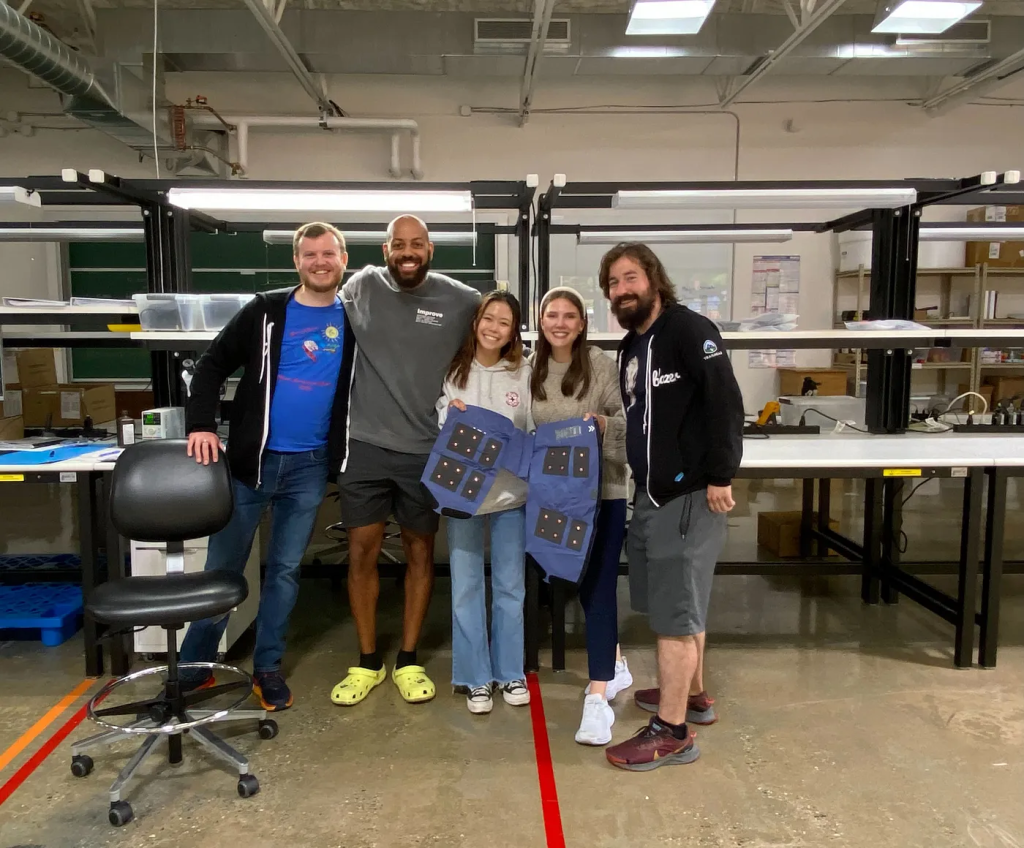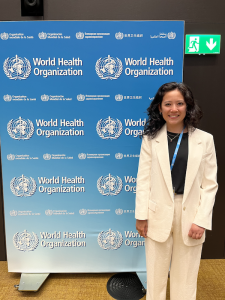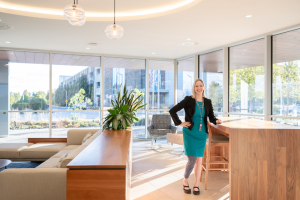
Over the last several decades, technology has played an incredibly important role in transforming the lives of people with mobility differences. From artificial prosthetics that restore a sense of touch for people with paralysis to bionic clothing that helps facilitate muscle re-education for people with upper motor neuron disorders, the fusion of technology and healthcare is contributing to medical breakthroughs that once felt impossible.
Here at CIONIC, we’re on a mission to superpower human mobility. We’ve seen incredible results with our FDA-cleared Cionic Neural Sleeve and we continue to think about ways to expand our platform. This summer, we invited four brilliant engineering interns to test the limits of this platform by building their own neuro-rehabilitation solutions using Cionic APIs.
The projects they selected are incredibly innovative and will undoubtedly contribute to CIONIC’s mission to enable people to move without limits.
Without further ado, here’s a deeper dive into each of our new team members and their projects.
Meet Lindsey
Meet Lindsey! She is a Computer Science and Mathematical Data Science double major at Dartmouth College. She has a keen interest in software development, 3D modeling, and software security.
At Dartmouth, she works as a research assistant at Emplower Lab, where she uses neural networks to model physical environments. Throughout her time at Empower Lab, she has also developed applications for AR/VR-based physical rehabilitation.
What motivated you to apply for an internship at CIONIC? What do you hope to gain from this experience?
“I found this position online and was so excited to see how much it aligned with my interests in software development and 3D modeling as well as my previous work experience using sensor devices for rehabilitation.
I instantly had a project idea that I wanted to bring to the company that incorporated musical rehabilitation with the neural sleeve. I thought it would be super cool to see how the Cionic sleeve could be incorporated into something I am extremely passionate about — music!
I hope I am able to expand upon and apply my skills in software and hardware development, while giving back to the community and making a difference in mobility improvement. I also hope to get to know the team and learn more about the ways in which technology can help people and improve their lives.
It has already been so amazing and heartwarming to be able to see the ways in which the sleeve has made a huge impact on people’s lives.”
Tell us about the project(s) you’re currently working on!
“I am using the Cionic Javascript-based Software Development Kit to design and develop an application to be featured within the Cionic system that allows a user to play rehabilitative musical exercises on a virtual piano through AR/VR devices with assistance from electrical stimulation.
I am hoping to also incorporate rehabilitation exercises through music-making exercises (ie. stretches to play a note on the piano). Eventually, I am also hoping to be able to implement a feature into the gloves so that users are able to be assisted with stimulation as they make music!”

Meet Caleb
Meet Caleb. He completed his bachelor’s degree in Biological Engineering with a Computer Science minor from Utah State University in Logan Utah.
From there, he decided to pursue a Ph.D. in Biomedical Engineering with an emphasis in Neural Engineering from the University of Utah within the NeuroRobotics Lab led by Dr. Jacob George.
Caleb is very interested in using technology to help the lives of people who have been affected by neuromuscular injury or disease.
What motivated you to apply for an internship at CIONIC? What do you hope to gain from this experience?
“I applied for this internship at CIONIC because I wanted to learn more about the company, the Neural Sleeve, and the medical device industry. I learned about CIONIC when Jeremiah came to my lab at the University of Utah. I was intrigued by the Neural Sleeve and how it is able to help so many individuals walk better and more.
I plan on pursuing a career in medical devices within neurotechnology and rehabilitation devices. I hope to gain some valuable experience within these fields in this internship and to learn more about software engineering within these fields.
My research at the University of Utah has used robotics to assist participants in movements. I applied to this internship to learn more about functional electrical stimulation and see what I could bring to this field.”
Tell us about the project(s) you’re currently working on!
“I am currently working on a project that uses muscle activity from one arm to stimulate the muscles in the other (EMG-triggered FES). I will be moving towards the goal of having EMG and FES on the same arm.
In addition to this main project, I am also trying to help update documentation for potential future interns or users of the research kit.”

Meet Joseph
Meet Joseph. In June, he graduated from North Seattle College with a Bachelor’s in Applied Science in Application Development.
Joseph is motivated by finding ways that tech can improve lives and make the world a better place. He’s also deeply curious about what’s possible with the growing AI landscape.
What motivated you to apply for an internship at CIONIC? What do you hope to gain from this experience?
“Honestly, reading the testimonials of users sharing how much their lives have improved since using the sleeve was the primary motivating factor. It’s very clear how deeply the team is invested in magnifying that positive impact for Cionic’s users. It feels very much like we’re quite literally building the future.
From a technology perspective, I was intrigued by the prospect of working with hardware and live signal data as I’ve not yet had the opportunity to do so. By the end of the summer, I hope to have gained more familiarity and comfortability in working with live signals from external devices, as well as have a greater understanding of kinesiology, rehabilitation, and the biotech space at large.”
Tell us about the project(s) you’re currently working on!
“My project can be seen as two-fold. The first aspect is mapping positioning and muscle activation to trigger sound and music generation. I view this implementation as a playground of sorts — presently consisting of a drum pad, pitch dial, and a synthesizer.
The pitch dial uses thigh rotation to adjust pitch which activates upon foot flexion. The synthesizer continuously emits sound and similarly adjusts pitch based on thigh rotation but also allows the layering of effects like reverb and vibrato based on shank extension and calf contraction.
The second aspect is using melody and chord construction in a layered biofeedback tool to work toward muscle synchronization and sequencing for various movements. A movement that requires muscles A and B to activate at the same time followed by muscle C could be mapped to generating two notes at the same time followed by a third note.
The motivating idea is to offer multiple avenues for one’s brain to take in and conceptualize a movement to support forming new neural connections for a given movement.”

Meet Lise
Meet Lise. Lise is a Norwegian-American physical therapist who loves coding. She has always loved science, especially physiology, which led her to pursue a degree in physiotherapy at the Norwegian University of Science and Technology in Trondheim, Norway.
After a year of working as a physical therapist, she realized she really missed working more hands-on with science and technology, and decided to pivot, hoping to use her background in health care to improve the technology that patients and healthcare workers use every day.
What motivated you to apply for an internship at CIONIC? What do you hope to gain from this experience?
“This summer I enrolled in The Norwegian School of Entrepreneurship, a postgrad program for those of us who are curious about innovation, or even want to start something of our own! An important part of the program is working in a startup, so I’m at CIONIC four days a week, and in class at UC Berkeley on Fridays.
While looking for a startup, CIONIC stood out to me immediately — what a perfect opportunity to combine my two fields and an awesome mission!
During the interview process, I got a really good feeling about the team; this is an incredibly dedicated and passionate group of people that really want to make a difference. I was sold!
From this experience, I want to learn about what kind of roles and skills a startup needs, learn more about what sets healthcare startups apart from those in other industries, as well as get better at software engineering. Last but not least, I’m here to have fun and meet awesome new people!”

Tell us about the project(s) you’re currently working on!
“Currently, I’m improving the accessibility of the CIONIC App. As a physical therapist, I’m super passionate about ensuring that spaces and products are equally accessible for all users, and believe firmly in the Gap Model of disability.
For context, this theory explains that disabilities occur in the gap between the individual’s abilities and their environment’s requirements. In order to narrow this gap, the environment must reduce its requirements, and that’s where I come in!
Simple adjustments allow for the phone’s own accessibility features to work seamlessly in the app. This helps to narrow the gap, ensuring that that content is legible and usable for everyone. This is an area in which most tech companies have room for improvement.”
In Conclusion
Thank you to our interns for their work in building innovative human augmentation applications and increasing overall accessibility within the CIONIC platform. Follow us on Instagram to stay updated on project progress throughout the remainder of the summer!





